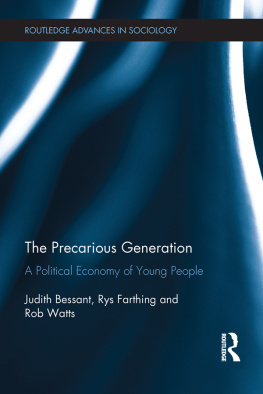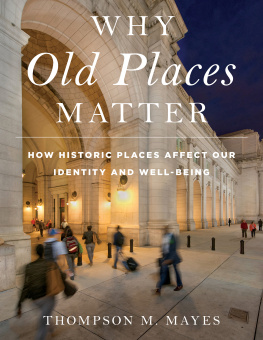Acknowledgments
This book would not have been possible without the generous contribution of the Life Patterns participants over more than twenty years. We want to acknowledge your generosity in sharing your lives with us. We wish to particularly thank the nineteen participants who agreed to an extensive interview in 2011.
The Life Patterns project was initiated by Peter Dwyer, who led it through its first phase. We acknowledge his contribution and that of other researchers who worked on the project. We are also grateful for the support of colleagues currently working on the Life Patterns project at the Youth Research Centre: Graeme Smith, Jessica Crofts, Chris Peterson and Dan Woodman, and Lesley Andres at the University of British Columbia. We wish to thank Graeme particularly for his support in the analysis of statistical data and Rhonda Christopher for her administrative support. The research is supported by a grant from the Australian Research Council.
We are grateful for the professional support provided by MUP, in particular to the Youth Series commissioner, publisher Foong Ling Kong, managing editor Diane Leyman, editor Cathryn Game and publicist Olivia Blake.
Finally, we would like to thank our families for their understanding and help during the writing process.
Hernn Cuervo and Johanna Wyn
Introduction
In our increasingly urbanised society, urban-based lives have come to be taken for granted as standard. When researchers want to gain an understanding of contemporary youth, they turn to metropolitan lives where, in the relationship between the biographies of individuals and the forces of social change, new approaches to life are forged. This means that young people in rural settings are inevitably seen as the other and even as a disadvantaged version of urban lives. This is reinforced by the tendency for policy-oriented research to compare rural with urban lives across many dimensions. This obscures the diversity that exists within and across locations, and inevitably reinforces the dichotomy between lives and conditions in rural and urban Australia. Urban settings are seen as ubiquitous, globalised and undifferentiated, and so place often disappears from the analysis of young peoples lives in general.
This book focuses on young people who live in rural settings in Australia. It draws on the longitudinal Life Patterns study to provide an insight into their hopes, decisions, relationships and trajectories over a period of more than twenty years, from the time they left secondary school in 1991 until 2011. Making their perspectives the central feature of the book, it explores the complexity of lives over time. As our analysis unfolds, the intersections between biography and location come to the foreground and the simple binaries of advantage/disadvantage and of rural/urban disappear, revealing how young adults work to achieve their goals, and how they respond to their circumstances. Unlike many contemporary analyses of young people in relation to rural places, this is not a story of comparative disadvantage, chronicling the ways in which rural youth are worse off than urban youth.
This is not to say that we ignore issues of disadvantage. Indeed, one of the themes that recurs through the book is social justice. Drawing on a longstanding interest in youth policy, we argue that education and labour market policies have significant implications for all young people. Our analysis of young people in rural places highlights the diversity and complexity of young lives, especially in an era of mass post-secondary education. As we show, young people go to extraordinary lengths to make their lives work. Policies that fail to take account of diversity simply reinforce patterns of disadvantage. Policies that take urban lives as standard risk consigning those who do not conform to the margins.
We are aware that from a policy perspective it is convenient to assume that standard markers or transition points of life, extracted from large-scale statistical measurement, provide a meaningful representation of lives over time. The spaces between key markers such as leaving school and getting a job are filled in by straight lines on a graph, giving the appearance of a smooth and sequential relationship between the two. Our analysis reveals what is happening in the spaces between these big events, making the connections between social relationships (to people and place) and education and employment more visible. When life is no longer sliced and diced into small, discrete areas, it is easier to see the processes that enable young adults to make their lives work.
The central theme of the book is captured in the title: Making It Work. This refers to the ways in which the young people have constructed their biographies in relation to rural placesand to the ways in which their life projects are influenced by the necessity of being reflexive subjects in neoliberal times. The main characters are nineteen young Australian people who are participants in the longitudinal Life Patterns study, which is based at the Youth Research Centre. As we explain in more detail below, these people are part of a cohort that has been responding to surveys since they left secondary school in 1991. Some of the nineteen people portrayed in this book were also part of a subset of the cohort that was interviewed at regular intervals along the way. All agreed to an extensive interview in 2011. The combination of longitudinal data sources from surveys and interviews offers a finely grained picture of their goals, their trajectories over time, their attitudes to life and their reflections on their journeys at particular points in time. The analysis explores how they have made their lives work.
Although the areas of education, employment and family traditionally used to map young peoples trajectories are highly relevant to their stories, these elements of life are merged rather than separate. The analysis presented in this book reinforces the significance of understanding the connection between different spheres of life. Young peoples relationship to places (actual locations as well as particular kinds of landscapes) are also closely interwoven through all of these elements. The place (and time) that young people inhabit are constructed through dynamic social relationships, processes and structures, including the links between the global and the local. Thus, we contribute to a growing body of literature that focuses on place as a way to analyse youth making sense of their lives.
Themes
Our analysis is informed by the work of other authors who have explored the relationship between place and biography from a range of disciplines, including sociology, political theory, geography and agricultural studies. These influences are evident in the recurring themes of our analysis: the relationship between age, biography and location; the theme of belonging; the idea of a distinctive generation; and the concept of social justice. These themes enable us to develop new insights into education, work and family in young peoples lives. We discuss each of these themes briefly below.
Age, biography and location
We are interested in understanding the dynamics of change and continuity that affect young peoples lives over time. This means that our analysis needs to take account of two kinds of transitional process: structural and economic changes that affect the nature of places, and biographical changes in individual lives. The decisions that young people make about their lives and the possibilities that they see for themselves are integrally connected to where they live in time and space. Hence locality and biography are connected in the lives of young people, and a focus on rural places has enabled this relationship to become visible. This emphasis on place-based practices necessarily entails examining the ordinary and the exceptional, looking into how young people understand and negotiate continuity and change in a particular space and time.





